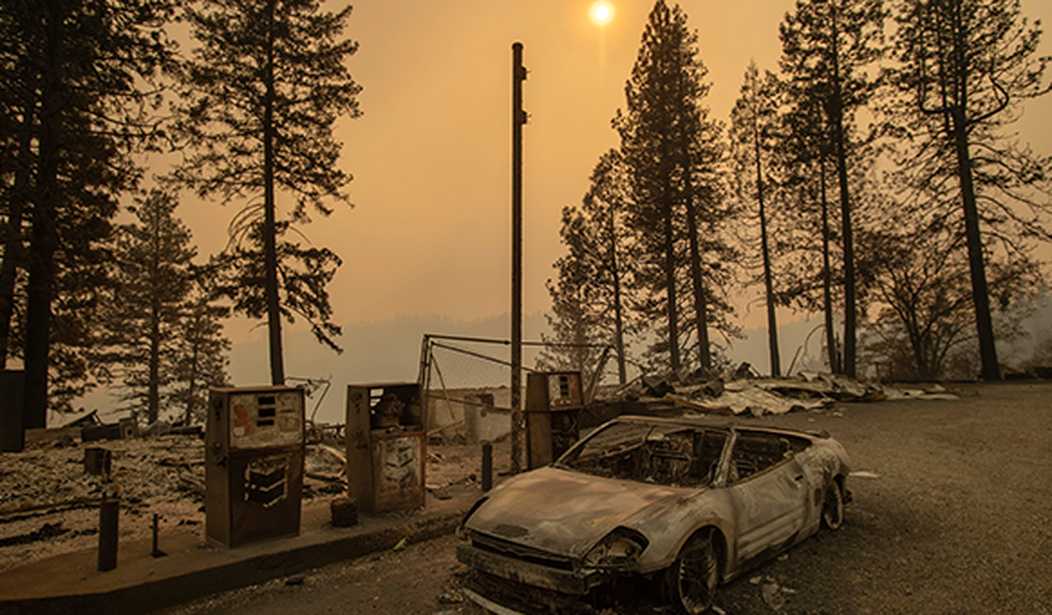The wildfires devastating California are terrible, but they are not a new phenomenon. Indeed, wildfires in California and throughout the Western United States have been common, seasonally, throughout history. However, in recent decades, the damage caused by and costs from wildfires has increased greatly.
For three years running, like a broken record playing the same notes over and over again, California Gov. Jerry Brown has blamed human caused climate change for the wildfires that have engulfed much of the Golden State. By contrast, President Donald Trump’s thoughts about the cause of the wildfires currently blazing in California came, in typical Trump fashion, via tweet:
“There is no reason for these massive, deadly and costly forest fires in California except that forest management is so poor. Billions of dollars are given each year, with so many lives lost, all because of gross mismanagement of the forests,” tweeted Trump on November 10, following up in a second tweet on November 11, “With proper Forest Management, we can stop the devastation constantly going on in California. Get smart!”
Concerning wildfires, Brown is wrong, Trump is right.
The average temperature in California has barely moved over the past 30 years, and numerous analyses, including Climate Change Reconsidered II: Physical Science, a peer-reviewed survey of the literature, demonstrate conclusively neither the Earth in general, nor California in particular have experienced worsened drought conditions or wildfires in greater number or size during the past 150 years—the period when carbon-dioxide-producing humans have purportedly been causing dangerous climate change.
By contrast, forest management has changed radically since George Herbert Walker Bush was elected president in 1988. Historically—prior to burdensome federal regulations—forests on federal lands were logged to provide lumber for commercial activities, to promote forest recreation, species protection and management, and to prevent wildfires.
Recommended
However, in recent decades forest management policies have substantially changed—and not for the better. Pressure and lawsuits from environmental lobbyists have prevented or delayed commercial and salvage logging, turning many of our national forests into tinderboxes. Moreover, environmentalists successfully lobbied to remove thousands of miles of forest roads, making it more difficult to fight wildfires before they endanger population centers.
Furthermore, timber harvests in the 155 national forests have plunged by more than 80 percent over the past two decades—from 12 billion board feet per year in the 1980s to less than 2 billion board feet per year in recent years. In the past, large ponderosa pines in the Western national forests grew in stands of 20 to 55 trees per acre compared to 300 to 900 trees per acre today. National forests in California have an estimated 10 to 20 times more trees than is “natural”—making them dangerously overgrown. The unnatural tree density allowed what were formerly isolated pockets of insect infestations to morph into massive infestations, killing large swaths of forests.
As a result, the U.S. Forest Service estimates more than 90 million acres are at “high risk” for catastrophic fires.
These factors, combined with California’s naturally arid climate and the seasonally regular, dramatic Santa Ana winds, create tinderbox conditions in California.
Simultaneously, federal and state water policies and California’s land use policies and restrictions have allowed and encouraged more and more people to move into and towns to expand into formerly uninhabited brushlands and forested areas. Even worse, these policies allow local authorities and residents little flexibility on how to manage the trees and brush on their land. In other words, government policies have exposed more people to wildfires. Fires burning far from homes and businesses still harm wildlife and habitat but don’t incinerate businesses, homes, or people.
The wildfire threat can be dealt with in three ways. First is the “Burn Baby Burn” option, which we are currently witnessing. This option is deadly, destructive, and unacceptable.
A second option would be to reinstitute past forest policies that allowed more mechanical thinning of vegetation and logging to reduce unhealthy forest land.
A third response to the problem of forest mismanagement would be to end federal ownership and control over all but the most sensitive, environmentally unique public lands.
One definition of insanity is doing the same thing over and over again and expecting different results. Through federal and state government agencies, environmentalists have ruled over California’s land and forest policies for 30 years—their abysmal results are visible in charred homes and lost lives.
Our forests, those who live near them, those who fight wildfires, and the members of the public who pay the bills deserve land use policies that place public safety above the flawed ideal of “letting nature take its course.” Research shows states, private individuals, conservation organizations, and companies manage the forests and other lands they own better than the federal government—with better water quality, higher biodiversity, and fewer dead and dying trees. Unhindered by bureaucratic government rules, forest product companies, sportsmen’s clubs, environmental groups, or other interested parties would be better able to prevent wildfires, by treating insect infestations that kill forests, promptly removing dead and dying timber to prevent infestations from spreading, keeping brush in check, and the number of trees per acre at an optimal level.
H. Sterling Burnett, Ph.D. (hburnett@heartland.org) is a senior fellow on energy and the environment at The Heartland Institute, a nonpartisan, nonprofit research center headquartered in Arlington Heights, Illinois.

























Join the conversation as a VIP Member